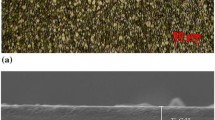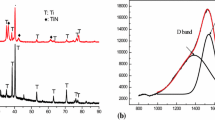Abstract
Titanium alloy (Ti6Al4V) surfaces are generally modified to achieve some specific surface properties to satisfy requirements of clinical medicine. In our work, hexadecylphosphonic acid (HDPA) films were successfully formed on Ti6Al4V and subsequently confirmed by X-ray photoelectron spectroscopy (XPS) and atomic force microscopy (AFM) measurements. The tribological properties of the HDPA-modified Ti6Al4V were investigated using a ball-on-disk tribometer with a linear reciprocating movement. Experimental results indicate that the HDPA-modified Ti6Al4V can maintain a low friction coefficient (approximately 0.06) for 4 h when sliding against polytetrafluoroethylene (PTFE) balls under a load of 0.8 N in comparison to bare Ti6Al4V (approximately 0.2); the friction coefficient of the HDPA-modified Ti6Al4V shows a 70% decline. In addition, the wear rate of PTFE balls sliding against bare Ti6Al4V was almost twenty times that of PTFE balls sliding against the HDPA-modified Ti6Al4V. Moreover, results of tribological experiments for different speeds (from 3 to 24 mm/s) and loads (from 0.8 to 3.2 N) proved that the HDPA-modified Ti6Al4V was not sensitive to both velocity and load. The friction coefficients were still low and stable even under a high load of 3.2 N or at a high speed of 24 mm/s. This indicates that this soft modification is an optional method of improving tribological properties of Ti6Al4V.
Similar content being viewed by others
References
Pitzen T, Kettler A, Drumm J, et al. Cervical spine disc prosthesis: Radiographic, biomechanical and morphological post mortal findings 12 weeks after implantation. A retrieval example. Eur Spine J, 2007, 16: 1015–1020
Lehman R, Bevevino A J, Brewer D D, et al. A systematic review of cervical artificial disc replacement wear characteristics and durability. Spine J, 2012, 3: 31–38
Auerbach J D, Jones K J, Fras C I, et al. The prevalence of indications and contraindications to cervical total disc replacement. Spine J, 2008, 8: 711–716
Zhang H Y, Luo J B, Zhou M, et al. Biotribological properties at the stem-cement interface lubricated with different media. J Mech Beh Biomed Mater, 2013, 20: 209–216
Mortazavi S M J, Molligan J, Austin M S, et al. Failure following revision total knee arthroplasty: Infection is the major cause. Int Orthop, 2011, 35: 1157–1164
Sekhon L H S, Duggal N, Lynch J J. Magnetic resonance imaging clarity of the Bryan, Prodisc-C, Prestige LP, and PCM cervical arthroplasty devices. Spine, 2007, 32: 673–680
Goffin J, Casey A, Kehr P, et al. Preliminary clinical experience with the Bryan Cervical Disc Prosthesis. Neurosurgery, 2002, 51: 840–847
Traynelis V C. The Prestige cervical disc replacement. Spine J, 2004, 4: S310–S314
Rack H, Qazi J. Titanium alloys for biomedical applications. Mater Sci Eng C, 2006, 8: 1269–1277
Dunlop I E, Thomas R K, Titmus S, et al. Structure and collapse of a surface-grown strong polyelectrolyte brush on sapphire. Langmuir, 2012, 28: 3187–3193
Chen L, Yang M C, Yu J X, et al. Nanofretting behaviours of ultrathin DLC coating on Si(1 0 0) substrate. Wear, 2011, 271: 1980–1986
Tang J G, Liu D X, Tang C B, et al. Surface modification of Ti-6Al-4V alloy by cathode assiting discharge setup and conventional plasma nitriding methods. Sci China Tech Sci, 2013, 56: 1858–1864
Luo Y, Yang L, Tian M C, et al. The friction and wear behavior of WC coating on medical grade titanium alloys. Proc I Mech Eng J-J Eng, 2013, doi: 10.1177/1350650112471255
Umeda J, Mimoto T, Kondoh K, et al. Tribological properties of titanium plate coated with carbon nanotubes. Key Eng Mat, 2013, 545: 158–162
Ripoll M R, Brenner J, Podgornik B. Friction and lifetime of laser surface-textured and MoS2-Coated Ti6Al4V under dry reciprocating sliding. Tribol Lett, 2013, 51: 261–271
Vangolua Y, Alsarana A, Yildirim O S. Wear properties of micro arc oxidized and hydrothermally treated Ti6Al4V alloy in simulated body fluid. Wear, 2013, 271: 2322–2327
Clewlow J P, Pylios T, Shepherd D. Soft layer bearing joints for spine arthroplasty. Mater Design, 2008, 29: 1981–1985
D’Andrea S C, Swaminathan Iyer K, Luzinov I, et al. Self-assembled monolayers of organophosphonic acids supported on teeth. Colloid Surface B, 2003, 32: 235–243
Silverman B M, Wieghaus K A, Schwartz J. Comparative properties of siloxane vs phosphonate monolayers on a key titanium alloy. Langmuir, 2005, 21: 225–228
Attavar S, Diwekar M, Linford M R, et al. Passivation of aluminum with alkyl phosphonic acids for biochip applications. Appl Surf Sci, 2010, 256: 7146–7150
Gawalt E S, Avaltroni M J, Koch N, et al. Self-Assembly and Bonding of Alkanephosphonic Acids on the Native Oxide Surface of Titanium. Langmuir, 2001, 17: 5736–5738
Mani G, Johnson D M, Marton D, et al. Stability of self-assembled monolayers on titanium and gold. Langmuir, 2008, 24: 6774–6784
Petrović Ž, Katić J, Metikoš-Huković M, et al. Modification of a nitinol surface by phosphonate self-assembled monolayers. J Electrochem Soc, 2011, 158: F159–F165
Schwartz J, Avaltroni M J, Danahy M P, et al. Cell attachment and spreading on metal implant materials. Mat Sci Eng C-Bio S, 2003, 23: 395–400
Viornery C, Chevolot Y, Léonard D, et al. Surface modification of titanium with phosphonic acid to improve bone bonding: characterization by XPS and ToF-SIMS. Langmuir, 2002, 18: 2582–2589
Raman A, Gawalt E S. Reduction of 3T3 fibroblast adhesion on SS316L by methyl-terminated SAMs. Mat Sci Eng C-Bio S, 2010, 30: 1157–1161
Piwoński I, Kisielewska A. Dialkyldithiophosphate Acids (HDDPs) as Effective Lubricants of Sol-Gel Titania Coatings in Technical Dry Friction Conditions. Tribol Lett, 2012, 45: 237–249
Moine M M, Roizard X, Melot J M, et al. Grafting and characterization of dodecylphosphonic acid on copper: Macro-tribological behavior and surface properties. Surf Coat Tech, 2013, 232: 567–574
Hanson E L, Schwartz J, Nickel B, et al. Bonding self-assembled, compact organophosphonate monolayers to the native oxide surface of silicon. J Am Chem Soc, 2003, 125: 16074–16080
Kurtz S M, Edidin A A. Spine Technology Handbook. Boston: Elsevier Academic Press, 2006
Scholes S C, Unsworth A, Blamey J M, et al. Design aspects of compliant, soft layer bearings for an experimental hip prosthesis. Proc the I Mech Eng H, 2005, 219: 79–87
Pu J B, Mo Y F, Wan S H, et al. Fabrication of novel graphene-fullerene hybrid lubricating films based on self-assembly for MEMS applications. Chem Commun, 2014, 50: 469–471
Liu Y H, Wang X K, Luo J B, et al. Fabrication and tribological properties of super-hydrophobic surfaces based on porous silicon. Appl Surf Sci, 2009, 255: 9430–9438
Pu J B, Wan S H, Zhao W J, et al. Preparation and tribological study of functionalized graphene-IL nanocomposite ultrathin lubrication films on Si substrates. J Phys Chem C, 2011, 115: 13275–13284
Neves B R A, Salmon M E, Troughton Jr E B, et al. Self-healing on OPA self-assembled monolayers. Nanotech, 2001, 12: 285–289
Lee S, Heeb R, Venkataraman N V, et al. Macroscopic tribological testing of alkanethiol self-assembled monolayers (SAMs): Pin-on-disk tribometry with elastomeric sliding contacts. Tribol Lett, 2007, 28: 229–239
Author information
Authors and Affiliations
Corresponding author
Rights and permissions
About this article
Cite this article
Zhang, C., Liu, Y. & Wen, S. Excellent tribological behavior of hexadecylphosphonic acid films formed on titanium alloy. Sci. China Technol. Sci. 57, 1816–1823 (2014). https://doi.org/10.1007/s11431-014-5572-7
Received:
Accepted:
Published:
Issue Date:
DOI: https://doi.org/10.1007/s11431-014-5572-7




